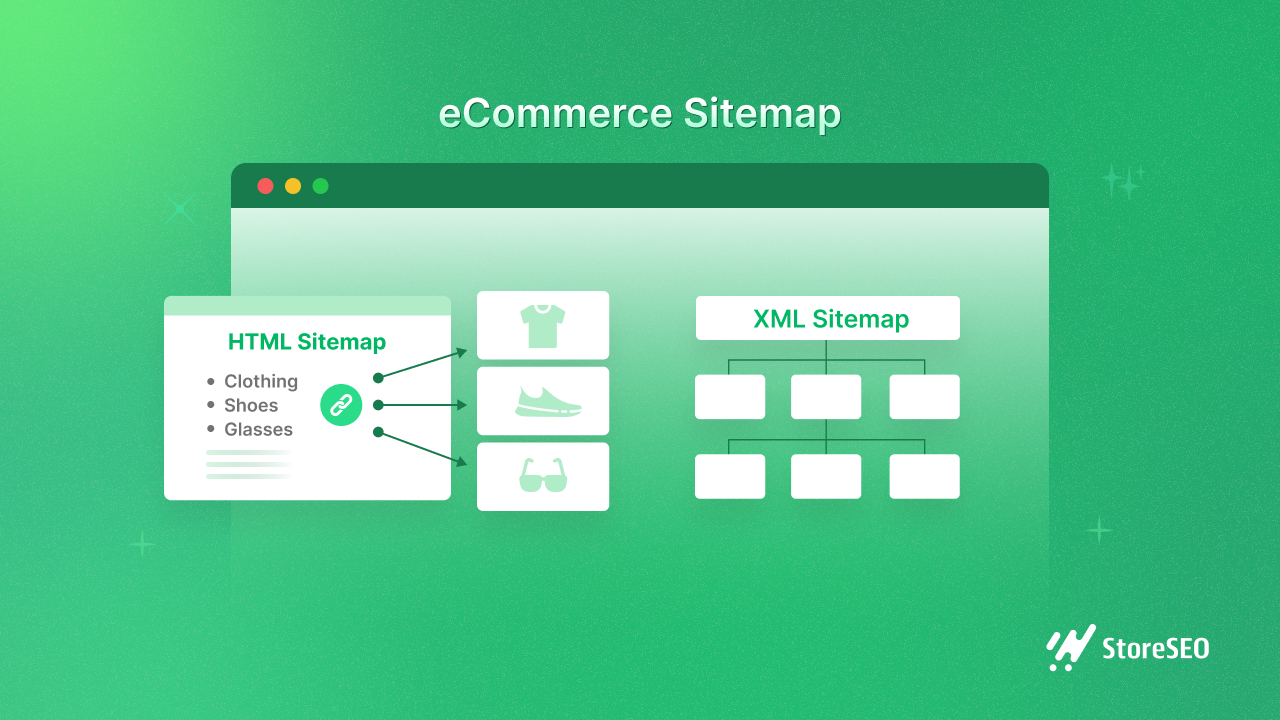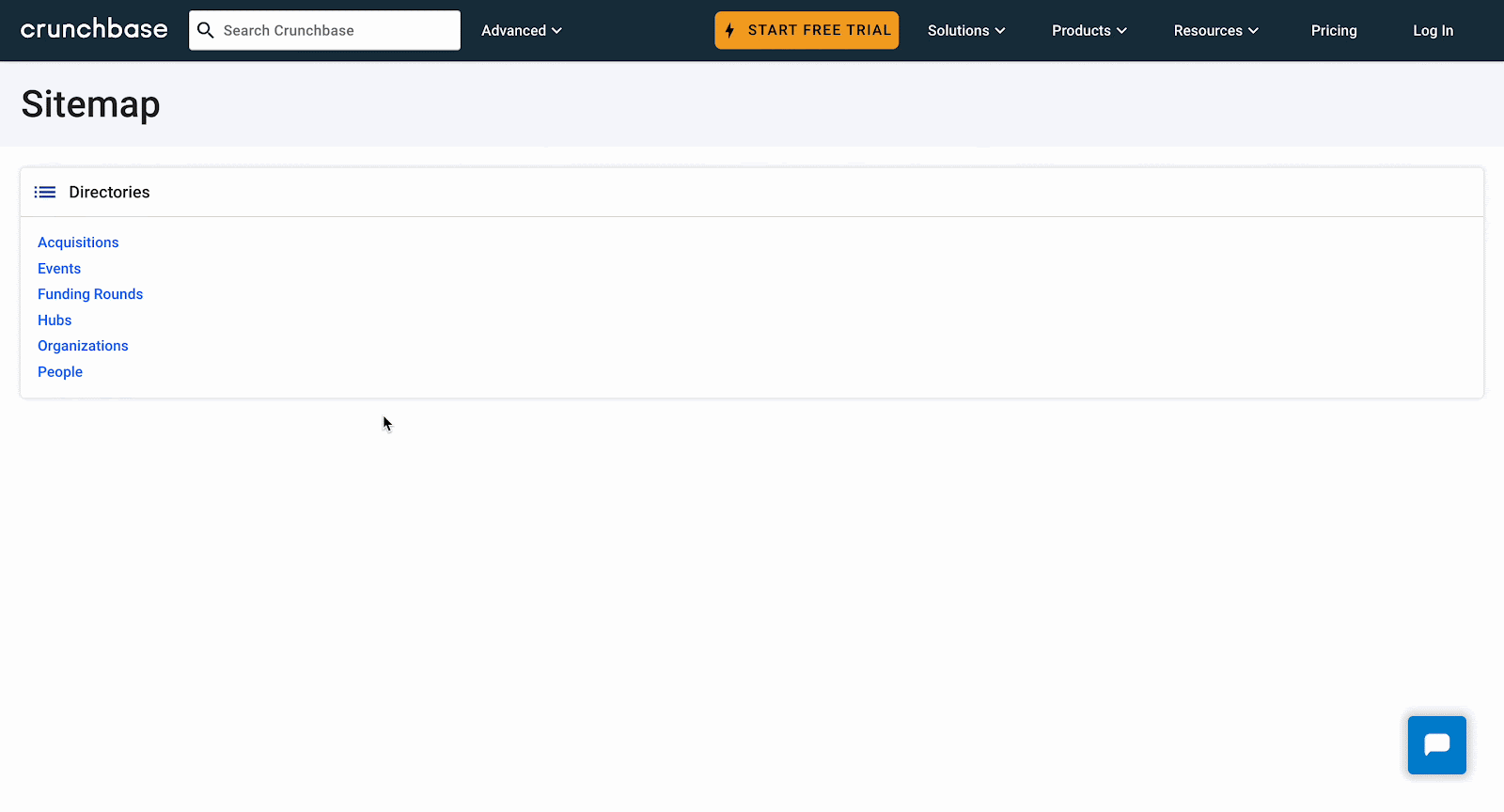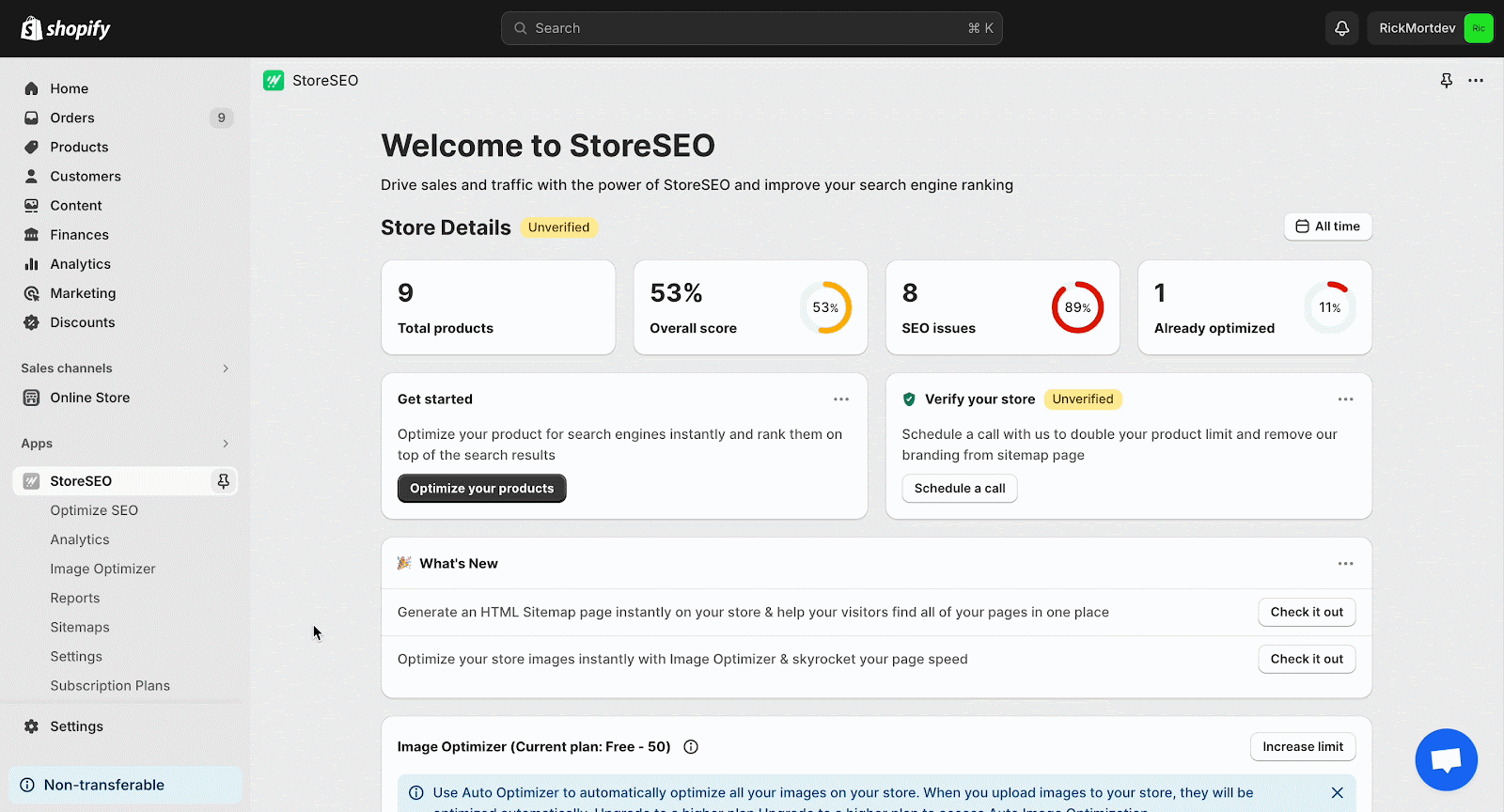Der eCommerce-Sitemap hilft, die Crawlbarkeit und Indexierung Ihres Shops zu verbessern, um organischen Traffic zu generieren. Wenn Sie einen großen E-Commerce-Shop haben, kann eine Sitemap Ihr ultimativer Schlüssel zum Erfolg im SEO-Spiel sein. In diesem Blog besprechen wir die Vor- und Nachteile von E-Commerce-Sitemaps. Lassen Sie uns also ohne weitere Umschweife loslegen.

Was ist eine E-Commerce-Sitemap?
Eine E-Commerce-Sitemap ist die Karte Ihres E-Commerce-Shops. Sie hilft Suchmaschinen-Crawlern, Ihre Webseiten zu finden und zu verstehen. Im Grunde handelt es sich dabei um eine Struktur der Website, die alle verschiedenen Seiten, Kategorien und Produkte enthält, die in Ihrem Shop verfügbar sind. So können Suchmaschinen-Crawler alle Seiten problemlos über diese Karte entdecken.
Arten von Sitemaps für E-Commerce-Shops
Sitemaps werden hauptsächlich in zwei Typen unterteilt: XML-Sitemap und HTML-Sitemap. Nachfolgend finden Sie weitere Einzelheiten zu diesen Sitemaps.
XML-Sitemap
Der XML-Sitemap ist eine Karte, mit der Suchcrawler alle Ihre Webseiten finden und verstehen können. Sie enthält eine strukturierte Liste aller Seiten-URLs Ihrer Website.
HTML Sitemap
Der HTML-Sitemap wurde speziell für Website-Besucher entwickelt. Es hilft dabei, alle Seiten einer Website an einem einzigen Ort zu finden.
XML VS. HTML eCommerce Sitemap
| Vergleichspunkt | XML eCommerce Sitemap | HTML eCommerce Sitemap |
| Zweck | Entwickelt für Suchmaschinen | Für Menschen konzipiert |
| Inhalt | Metadaten zu den Webseiten, beispielsweise ihre Wichtigkeit, Aktualisierungshäufigkeit und Beziehung zu anderen URLs innerhalb der Site. | Konzentrieren Sie sich auf eine benutzerfreundliche Navigation, indem Sie Links hierarchisch und kategorisch organisieren. |
| Anwendungsfall | Hilft beim Indizierungsprozess für verschiedene Suchmaschinen und verbessert die Sichtbarkeit der Website in den Suchergebnissen. | Dient als benutzerfreundliche Karte, mit der Besucher schnell bestimmte Seiten oder Produkte auf einer einzigen Seite finden können |
Andere Arten von Sitemaps, die in E-Commerce-Shops verwendet werden
Zuvor haben wir die beiden wichtigsten Sitemap-Typen besprochen. Darüber hinaus gibt es jedoch noch drei weitere Typen, die häufig in E-Commerce-Shops verwendet werden. Lassen Sie uns im Folgenden tiefer eintauchen und diese Sitemaps genauer untersuchen.
TXT(text) Sitemap
Die TXT-Sitemap (Text) ist eine einfache Textdatei, die eine Liste aller Ihrer Seiten-URLs im Nur-Text-Format enthält. Im Gegensatz zu XML-Sitemaps bieten TXT-Sitemaps den Crawlern der Suchmaschinen nicht so viele Details.
Bilder-Sitemap
Eine Bilder-Sitemap ist eine weitere Art von XML-Sitemap, die Suchmaschinen beim Crawlen von Bildern auf Ihrer Website hilft. Sie enthält HTML-Tags zur Identifizierung bestimmter Bilder, um den Crawlern das Verständnis Ihrer Website zu erleichtern.
Video-Sitemaps
Der Video-Sitemap bietet zusätzliche Informationen zu den Videos, die Sie auf Ihrer Website hosten. Es hilft den Suchmaschinen-Crawlern, den Videoinhalt Ihrer Website zu verstehen und zu finden, indem es zusätzliche Informationen wie Videotitel, Beschreibung, Dauer und Miniaturbilder bereitstellt.
Was ist das beste Sitemap-Format für E-Commerce?
Unter den verschiedenen Sitemaptypen ist die XML-Sitemap die beste Wahl für E-Commerce-Websites. Wenn Sie eine große E-Commerce-Website haben, kann eine XML-Sitemap den Suchmaschinen-Crawlern helfen, alle Ihre Seiten problemlos zu finden.
Außerdem ist eine HTML-Sitemap eine großartige Ergänzung für E-Commerce-Shops. Wenn Ihr Shop viele Kategorien und Seiten hat, kann Ihnen eine HTML-Sitemap dabei helfen, alle diese Seiten und Kategorien an einem Ort zusammenzuführen. Auf diese Weise können Ihre Besucher jede gewünschte Seite ganz einfach finden.
Was ist in einer E-Commerce-Sitemap enthalten?
Die eCommerce-Sitemap enthält strukturierte Informationen über Ihre Website. Sie enthält die URLs Ihrer Website in der … Tag. Es handelt sich um den übergeordneten Tag für die URLs Ihrer Website, dem Sie über untergeordnete Tags weitere Informationen hinzufügen können.
In der eCommerce-Sitemap Tag wird verwendet, um die kanonischen URLs anzugeben. Außerdem ist der Tag enthält die Informationen zur Seitenänderung. Ebenso können Sie Tags wie Und um die Priorität und Aktualisierungshäufigkeit jeder Seite anzugeben, damit die Suchmaschinen Ihre Seiten besser verstehen. Sehen Sie sich das folgende Beispiel einer XML-Sitemap für eCommerce an.

Wie hilft eine Sitemap bei der SEO eines E-Commerce-Shops?
Sitemaps helfen bei der SEO von E-Commerce-Shops, indem sie eine effiziente Durchsuchbarkeit und Navigation für Suchmaschinen und Besucher gewährleisten. Sehen wir uns die Vorteile von Sitemaps unten genauer an.
Verbessern Sie Benutzererfahrung und Navigation
Eine E-Commerce-Website enthält unzählige Links und verschiedene Seiten. Die Besucher können sich darin leicht verirren. Wenn es also um Navigation und Benutzererfahrung geht, kann eine E-Commerce-Sitemap für Sie nützlich sein. Schauen Sie sich die Crunchbase-Website um zu sehen, wie sie alle Links für eine einfache Navigation organisiert halten.

Crawlbarkeit und Indexierung verbessern
Eine Sitemap bietet Suchmaschinen-Crawlern eine Übersicht über die Struktur Ihrer Website und ermöglicht so eine effizientere Entdeckung und Navigation aller Seiten. Dies ist besonders nützlich für große E-Commerce-Plattformen mit vielen verschiedenen Produkt- und Seitenkategorien. Wenn Sie alle URLs Ihrer Website zur Sitemap hinzufügen, z. B. Produktlisten, Kategorieverzeichnisse und wichtige Zielseiten, können die Suchmaschinen-Bots Ihre Website leichter crawlen.
Bewahren Sie interne und externe Links an einem Ort auf
Wenn Ihre E-Commerce-Site Millionen interner und externer Links enthält, wird es für Suchmaschinen-Crawler schwierig, sie alle zu verfolgen. Mit einer XML-Sitemap können Sie alle internen und externen Links einfach an einem Ort aufbewahren, sodass Suchmaschinen die Struktur Ihrer Website für die Indexierung leichter verstehen können.
Steuerungspriorität und Frequenzeinstellungen
Mit der XML-Sitemap können Sie die Priorität und Aktualisierungshäufigkeit jeder Seite festlegen. Auf diese Weise können Suchmaschinen die Wichtigkeit verschiedener Seiten bestimmen und bestimmen, wie häufig sie für Aktualisierungen gecrawlt werden sollten. Sie können beispielsweise Produktseiten gegenüber anderen, weniger wichtigen Seiten priorisieren.
Der beste Weg, eine E-Commerce-Sitemap für Shopify zu erstellen
In diesem Abschnitt zeigen wir Ihnen, wie Sie E-Commerce-Sitemaps für Ihren Shopify-Shop erstellen können. Befolgen Sie also die folgenden Schritte, um Sitemaps für Ihren Shop zu generieren.
So erstellen Sie eine XML-Sitemap in Shopify
Shopify generiert automatisch eine XML-Sitemap für Ihren Shop. Sie müssen also keine XML-Sitemap für Ihren Shop erstellen. Um Ihre Sitemap zu finden, müssen Sie am Ende Ihrer Shop-URL „/sitemap.xml“ hinzufügen und den Link aufrufen. Da es sich um eine automatisch generierte Sitemap handelt, benötigen Sie einen Shopify-Sitemap-Generator wie StoreSEO, um Bearbeiten oder aktualisieren Sie Ihre Sitemap.
So erstellen Sie eine HTML-Sitemap in Shopify
HTML-Sitemaps verbessern das Benutzererlebnis Ihrer Besucher. Mit der StoreSEO-App können Sie kostenlos HTML-Sitemaps in Shopify erstellen. Befolgen Sie die folgenden Schritte, um eine HTML-Sitemap für Shopify Geschäfte.
Schritt 1: Installieren Sie StoreSEO in Ihrem Store
Zunächst einmal werden Sie StoreSEO installieren in Ihrem Shopify-Shop. Suchen Sie im App Store nach StoreSEO und installieren Sie es in Ihrem Shop.

Schritt 2: Sitemap für Shopify generieren
Sobald Sie StoreSEO installiert haben, gehen Sie zur HTML-Sitemap und klicken Sie auf „Erzeugen'-Schaltfläche. Das ist alles, so können Sie mit StoreSEO ganz einfach eine Sitemap in Shopify erstellen. Jetzt können Sie die URL Ihrer HTML-Sitemap von dort kopieren und diesen Link überall einfügen, wo Sie möchten. Wenn Sie Schritt für Schritt lernen möchten, können Sie dies lesen Dokumentation.

Falls Sie andere E-Commerce-Plattformen verwenden
Haben Sie eine E-Commerce-Website auf anderen Plattformen? In diesem Fall können Sie das folgende Kurztutorial zum Erstellen Ihrer Sitemap lesen.
Sitemap in WooCommerce (WordPress) erstellen
Für WooCommerce können Sie Ihre Sitemap ganz einfach mit einem SEO-Plugin wie Rank Math erstellen. So erstellen Sie eine Sitemap in WordPress:
- Installieren und aktivieren Sie Rank Math auf Ihrer Website.
- Navigieren Sie zu den Einstellungen des Plugins und aktivieren Sie XML-Sitemaps.
- Das Plugin generiert automatisch eine Sitemap für Ihren WooCommerce-Shop.
Sitemap in BigCommerce erstellen
BigCommerce generiert und aktualisiert Ihre Sitemap automatisch. Sobald Sie sie aktiviert haben, müssen Sie sich keine Gedanken mehr über die Sitemap machen. Hier ist eine kurze Anleitung für Sie:
- Melden Sie sich bei Ihrem BigCommerce-Dashboard an.
- Gehen Sie zu Store Setup → 'Schaufenster'.
- Aktivieren Sie im Abschnitt „XML-Sitemap“ die XML-Sitemap.
Sitemap in Wix erstellen
Die Website-Erstellungsplattform Wix generiert automatisch eine Sitemap für Ihre Website. Hier ist eine kurze Anleitung zum Einreichen Ihrer Sitemap:
- Melden Sie sich bei Ihrem Wix-Konto an.
- Gehen Sie zum Dashboard Ihrer Site und klicken Sie auf „Suchmaschinenoptimierung' (unter Marketing & SEO).
- Wählen 'Sitemap' und klicken Sie dann auf 'Sitemap übermitteln'.
Sitemap in Squarespace erstellen
In Squarespace können Sie auch ganz einfach eine Sitemap erstellen. So erstellen Sie eine Sitemap in Squarespace:
- Melden Sie sich bei Ihrem Squarespace-Konto an.
- Gehe zu 'Einstellungen' → 'Fortschrittlich' → 'Suchmaschinenoptimierung'.
- Scrollen Sie nach unten zum Abschnitt „Sitemap“ und klicken Sie auf „Sitemap generieren' Taste.
So übermitteln Sie eine Sitemap an die Google Search Console
Nachdem Sie eine Sitemap für Ihren Shop erstellt haben, müssen Sie diese an die Google Search Console übermitteln. Für Ihren Shopify-Shop können Sie Ihre Sitemap manuell an Google übermitteln oder die StoreSEO-App verwenden. Um Ihre Sitemap zu übermitteln, folgen Sie dem unten bereitgestellten Tutorial.
So übermitteln Sie eine Sitemap manuell
Wenn Sie über ausreichend technische SEO-Kenntnisse verfügen, können Sie Ihre Sitemap manuell an die Google Search Console übermitteln. Zunächst müssen Sie Verbinden Sie Ihren Shop mit der Google Search Console manuell und gehen Sie dann zur Registerkarte „Sitemap“ in der Google Search Console.
Geben Sie nun Ihre Sitemap-URL ein und klicken Sie auf „Einreichen'-Schaltfläche. Sobald Sie Ihren Shop verbunden haben, geben Sie einfach „/sitemap.xml“, bevor Sie auf die Schaltfläche „Senden“ klicken.

So übermitteln Sie eine Sitemap mit StoreSEO
Wenn Sie nicht viel technisches SEO-Know-how haben, können Sie StoreSEO verwenden, um Ihre Sitemap einzureichen. Es ist in die Google Search Console integriert, sodass Sie Ihre Sitemap für Ihr Shopify-Dashboard einreichen können.
Navigieren Sie einfach zu 'Einstellungen' → 'Google-Integration‘ und geben Sie dann die erforderlichen Berechtigungen einfach durch Klicken auf die Schaltflächen. So können Sie Ihre Sitemap ganz einfach bei StoreSEO einreichen. Sie können lesen diese Dokumentation für schrittweise Anleitungen.

So erstellen Sie die Sitemap-URL: Best Practice
Wie bereits erwähnt, erstellt Shopify Sitemaps und URLs automatisch. Sie müssen sich also nicht um Best Practices für Sitemap-URLs kümmern. Hier sind die Richtlinien, die Sie beim Generieren einer Sitemap-URL befolgen sollten:
Verwenden der Stammdomäne
Platzieren Sie die Sitemap auf der Stammebene Ihrer Domain (z. B. https://www.example.com/sitemap.xml). Dadurch wird eine einfache Zugänglichkeit und Standardisierung über alle Suchmaschinen hinweg gewährleistet.
Best Practices für eCommerce-Sitemaps: So maximieren Sie die SEO-Vorteile
Sitemaps helfen, Ihre SEO durch verbesserte Crawlbarkeit zu verbessern. Sie dienen den Suchmaschinen-Bots als Karte Ihrer Website. In diesem Abschnitt teilen wir einige der Best Practices mit Ihnen, die Sie befolgen sollten, um Ihre SEO-Vorteile zu maximieren.
Sitemap regelmäßig aktualisieren
Wenn Sie eine Sitemap regelmäßig aktualisieren, hilft dies dem Crawler, die Änderungen zu verstehen, die Sie an Ihrer Website vornehmen. Hier finden Sie die Dos und Don'ts beim Aktualisieren einer Sitemap.
| DOS | Was Sie nicht tun sollten |
| ⭐ Fügen Sie Ihre neuen Seiten hinzu ⭐ Entfernen Sie die gelöschten Seiten ⭐ Achten Sie darauf, die Häufigkeit und Priorität zu aktualisieren ⭐ Verwenden Sie die Daten der letzten Änderung ⭐ Testen Sie Ihre Sitemap, um sie fehlerfrei zu halten | ⭐ Verwenden Sie keine irrelevanten URLs oder Links mit doppeltem oder minderwertigem Inhalt ⭐ Vergessen Sie nicht, die Änderungen einzureichen ⭐ Missbrauchen Sie nicht die Frequenz und Priorität ⭐ Ignorieren Sie die Fehlermeldung nicht |
Häufig gestellte Fragen
Bevor wir diesen Artikel abschließen, möchten wir einige der häufigsten Fragen beantworten, die in Communities und Foren gestellt werden.
Ist eine fehlende oder unvollständige Sitemap schlecht für E-Commerce-Shops?
Sie haben vielleicht schon viele Diskussionen über fehlende oder unvollständige Sitemaps miterlebt und suchen wahrscheinlich nach der richtigen Antwort. Eine E-Commerce-Sitemap hilft Suchmaschinen dabei, Ihre Seiten zu finden. Wenn Sie ein großes Geschäft haben, sorgen Sitemaps dafür, dass Ihr Geschäft richtig gecrawlt werden kann.
Wenn Sie jedoch ein kleines Geschäft haben, ist die Übermittlung einer Sitemap für Sie kein Muss. Stattdessen ist die Verlinkung Ihrer Seiten wichtiger, um die Crawler der Suchmaschinen anzuleiten. In diesem Fall sollten Sie Ihre interne Seitennavigation, Breadcrumbs oder Fußzeilen richtig verlinken, um diese Seiten bei Google zu indizieren.
Eine Sitemap bietet den Suchmaschinen-Bots eine Übersicht über Ihren Shop. Sie spart Crawling-Budget und hilft dabei, Ihre wichtigen Seiten schneller zu indizieren. Sie sollten also versuchen, für Ihren E-Commerce-Shop geeignete Sitemaps zu verwenden.
Wie finde ich die Shopify XML-Sitemap?
Sie können die XML-Sitemap des Shopify-Shops finden, indem Sie „/sitemap.xml“ an den Domänennamen Ihres Shops anhängen. Wenn die Domäne Ihres Shops beispielsweise „example.myshopify.com“ lautet, dann wäre die URL für Ihre XML-Sitemap „example.myshopify.com/sitemap.xml“.
Welche Tools gibt es zum Erstellen einer E-Commerce-Sitemap?
Shopify verfügt über integrierte Funktionen zum Generieren von XML-Sitemaps. Sie können Tools wie StoreSEO verwenden, um Ihre XML-Sitemap zu aktualisieren und eine HTML-Sitemap zu generieren.
Steigern Sie Ihre Shopify-SEO mit der eCommerce-Sitemap
Die E-Commerce-Sitemap ist ein wirkungsvolles Mittel, um Ihre SEO-Bemühungen bei Shopify zu verbessern. Indem Sie es Suchmaschinen erleichtern, Ihre Site zu crawlen und zu indexieren, können Sie die Sichtbarkeit Ihres Shops verbessern und mehr qualifizierten Traffic auf Ihre Produkte lenken. Vernachlässigen Sie also nicht die Bedeutung einer gut optimierten Sitemap in Ihrer SEO-Strategie für Shopify.
Fanden Sie diesen Blog nützlich? Wenn ja, dann bitte Abonnieren Sie unseren Blog für weitere nützliche Anleitungen, Blogs und Shopify-Updates.









